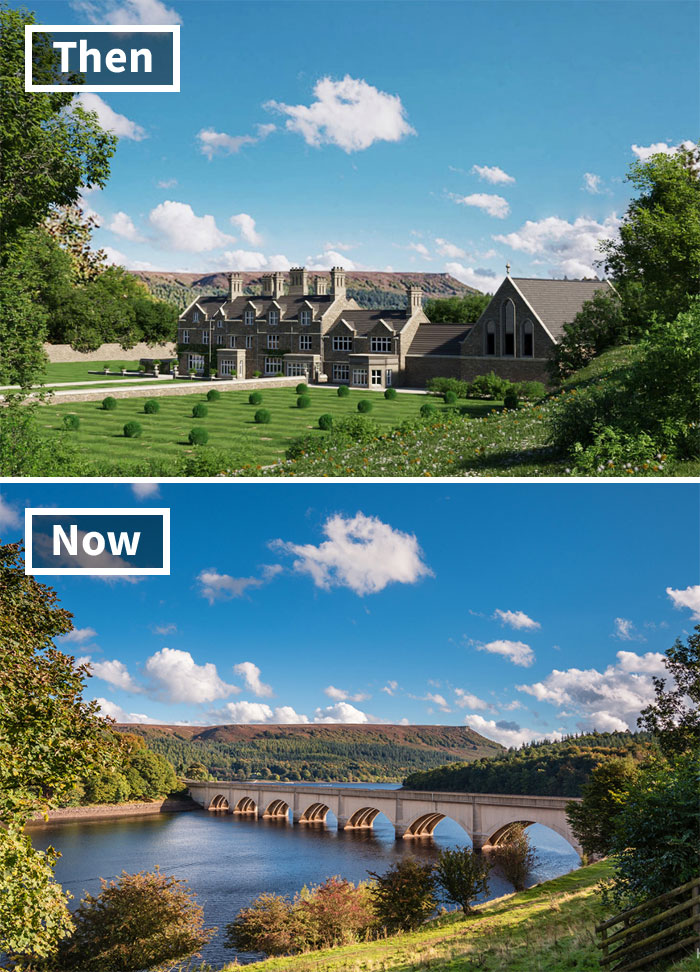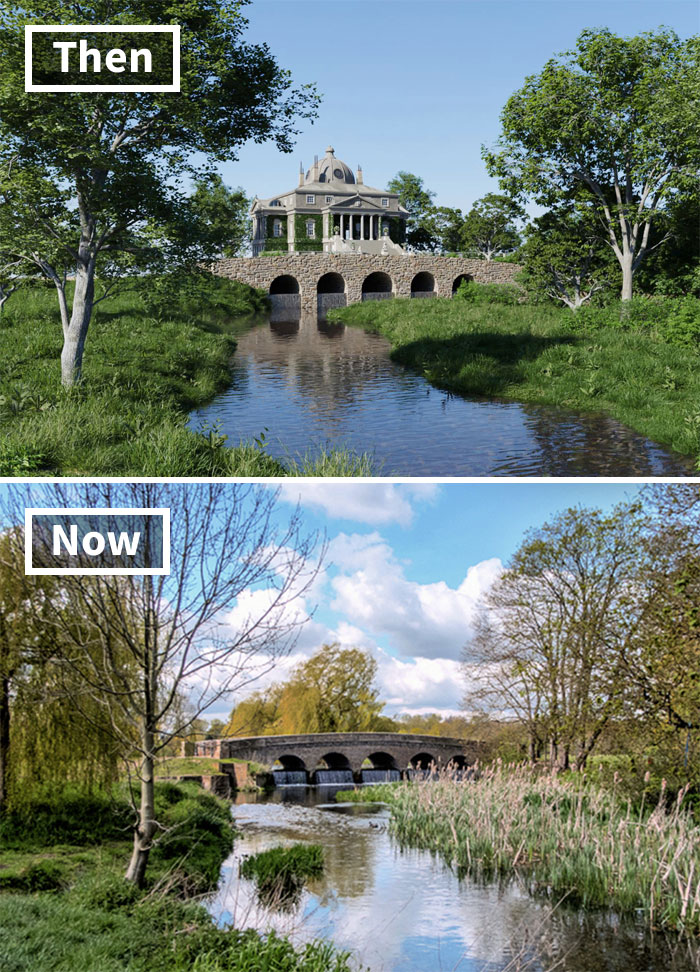
7 Recreations Of Long-Lost English Country Mansions Compared To What Stands In Their Place Today
According to Household Quotes, a website that helps people find tradesmen for various household jobs, around 2,000 historic country houses have been destroyed in England during the past 200 years. Recently, the website published a series of renderings of the long-lost mansions, giving us a unique glimpse at how they looked in their heyday. They even went on to compare the recreations to what stands in the same lots today!
Check out the fascinating recreations of historical English mansions compared to what stands in their place today in the gallery below!
More info: householdquotes.co.uk
#1 Hooten Hall (Ellesmere Port, Cheshire)

Image source: Household Quotes
Samuel Wyatt (brother of James) built this neo-classical, villa-style manor house for the 5th Baronet of Hooten in the late 19th-century. A banker named Richard Christopher Naylor later bought the house and enlarged it in a grand Italianate style. Naylor’s additions included a 100-foot clock-tower, a colonnaded sculpture gallery, and a racecourse.
Naylor moved out in 1875 but continued to fund the house through the racecourse. The army used the house as a hospital and an officer’s mess during World War I. They continued to use the estate as an airfield until 1957, by which time the house had long since been demolished. However, the house columns were reused for a gloriette in the bizarre real-life fantasy village of Portmeirion.
#2 Whiteknights Park (Sonning, Berkshire)

Image source: Household Quotes
Whiteknights Park House was a fine Italianate mansion at the heart of a medieval manor. The Marquis of Blandford acquired Whiteknights in 1798 and blew his fortune on the libraries and gardens… and parties. Guests included Queen Charlotte, her son, King George IV, and author Mary Russell Mitford, and wine was brought up from Blandford’s 12,000-bottle cellar.
In 1819, Blandford – now a duke – lost the estate when he went bankrupt. The house was demolished in 1840. Rumors persist that it was ripped apart by Blandford’s creditors, but it’s more likely to have been condemned after 20 years of neglect.
#3 Cassiobury House (Watford, Hertfordshire)

Image source: Household Quotes
Sir Richard Morison was awarded “the lordship or manor of Cayshobury” in 1546. He started building an Elizabethan-style house but was forced into exile as a supporter of the Reformation. His son later completed the fifty-six-room house, and architect Hugh May expanded it in a baroque fashion for the Capel family a century later.
Fast-forward to 1799 or so, and the 5th Earl of Essex commissioned James Wyatt (of Eridge Castle fame) to remodel Cassiobury in a neo-Gothic style. However, the house was poorly maintained through the 1800s, and the owners sold off family valuables to afford its upkeep. It was rented out during the early 1900s, sold in 1922, and demolished in 1927 to make way for urban sprawl.
#4 Derwent Hall (Derwent Valley, Derbyshire)

Image source: Household Quotes
This H-shaped home was built from local stone in 1672 and featured traditional Jacobean-style windows. The hall went on to become a farmhouse and a school during its 272-year existence.
You may notice that Derwent Hall looks considerably wetter in the ‘after’ image. That’s because authorities intentionally ‘drowned’ the entire village of Derwent in 1945 to create the Ladybower reservoir. The hall and other buildings were demolished ahead of the process in 1944.
#5 Eridge Castle (Eridge Green, Sussex)

Image source: Household Quotes
The Nevill family inherited Eridge Estate in the High Weald of Kent in 1448, and Queen Elizabeth I guested here for a week in 1573. Around 1787, the “ultra fantasist” James Wyatt adapted the castle in the derided Strawberry Hill Gothic style as a home for Henry Nevill, 2nd Earl of Abergavenny.
The family demolished the ‘castle’ in the 1930s to make way for a smaller, more modern home. Today, the estate remains in the Nevill family.
#6 Foots Cray Place (Foots Cray, Kent)

Image source: Household Quotes
Only four English country houses were designed directly under Andrea Palladio’s Villa Rotunda’s influence – the building that kickstarted the neoclassical architectural trend. Foots Cray was one of them. Commissioned in 1754, Foots Cray was requisitioned as a naval academy during WW2 and burned in mysterious circumstances in 1949.
“The original design had four porticoes,” wrote one observer in 1790, “three of which are filled up to gain more room. The hall is octagonal and has a gallery, ornamented with busts leading to the bed-chambers. It is enlightened from the top and is very beautiful. The edifice is built of stone, but the offices, which are on each side at some distances, are of brick.”
#7 Addington Manor (Addington, Buckinghamshire)

Image source: Household Quotes
Philip Charles Hardwick built Addington for John Hubbard (later the 1st Baron Addington), former Governor of the Bank of England, in 1856-7. Hardwick is remembered for the neo-classical Doric Arch and Great Hall at Euston Station but exercised a fantasy French chateaux style for Addington.
The brick house had quoins and dressings of Bath stone. Its oak hall featured an ornate ceiling that replicated the house ceiling that had previously stood on the site. Addington became a school during WWI and later a guest house and hotel. Sadly, it was demolished in 1928 to make way for a more conservative neo-classical/Georgian mansion.













Got wisdom to pour?